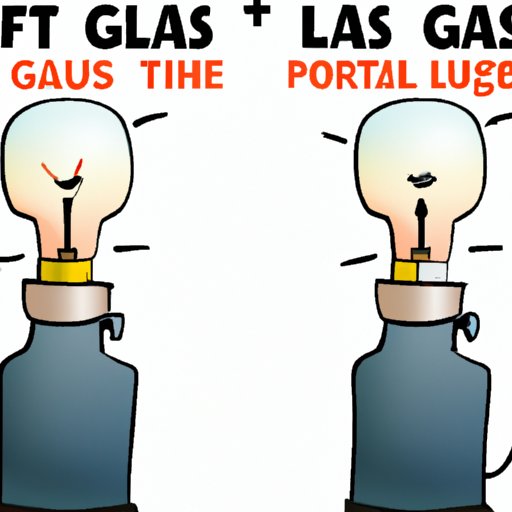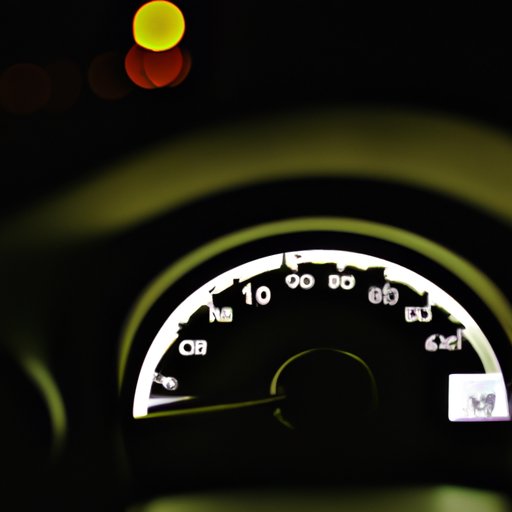Introduction
For many drivers, it’s an all too familiar scenario. You’re out and about, running errands or heading to work, when you suddenly notice the low gas light on your dashboard. You know you should stop and refuel, but you keep thinking “how far can I go with this?” In this article, we’ll explore just how far you can go with the gas light on, and provide some helpful safety tips and alternatives to driving with a low gas level.
Exploring How Far You Can Drive with a Low Gas Light
The first thing to understand about your vehicle’s gas light is that it’s meant to be a warning signal. It’s not a precise indicator of how much fuel you have left in the tank, and it’s definitely not a measure of how far you can travel before you run out of gas. The exact amount of fuel remaining in the tank will vary from vehicle to vehicle, so it’s important to remain cautious whenever you see the gas light come on.

Pros and Cons of Ignoring the Gas Light
Ignoring the gas light and pushing your luck by trying to make it further down the road is a risky proposition. If you do make it to the next station before running out of gas, you may save yourself a bit of time and hassle. However, if you don’t make it, you could end up stuck on the side of the road with an empty tank and no way to get to your destination. Additionally, running your car on an empty tank can cause damage to the fuel pump, which is an expensive repair.

Tips for Maximizing Fuel Efficiency When the Gas Light is On
If you decide to push your luck and drive with the gas light on, there are some steps you can take to maximize your fuel efficiency. First, slow down and avoid rapid acceleration. This will help conserve fuel and reduce the amount of fuel consumed. Second, use cruise control whenever possible. Cruise control helps maintain a consistent speed, which can help improve fuel efficiency. Finally, try to reduce the number of stops you make. Each time you stop and start your car, you’re burning more fuel than if you had kept going.
What to Do When You Run Out of Gas While Driving
If you do find yourself stranded on the side of the road with an empty tank, there are a few things you should do. First, turn on your hazard lights and call for help. Roadside assistance or a tow truck can help get you back on the road quickly. Second, stay in your car until help arrives. It’s important to remain visible and alert in case other drivers need to take evasive action. Finally, if you’re able to safely move your car off the road, do so. This will help reduce the risk of an accident.
Calculating How Far You Can Go with the Gas Light On
It’s impossible to predict exactly how far you can drive with the gas light on, as this will depend on a variety of factors such as the size of your fuel tank, the amount of fuel remaining in the tank, and your driving habits. Generally speaking, most cars can travel between 30 and 50 miles after the gas light comes on, though this can vary significantly depending on the vehicle.

Alternatives to Driving When the Gas Light is On
If you’re looking for an alternative to driving when the gas light is on, there are a few options available. Carpooling is a great option if you know someone who is headed in the same direction as you. Taking public transportation can also be a good option, especially if you’re headed to a major city or town. Finally, ride-sharing services such as Uber and Lyft can be a convenient and affordable way to get around when you’re low on fuel.
Conclusion
In conclusion, it’s important to remember that the gas light is a warning signal, not a precise measurement of how much fuel you have left in the tank. Ignoring the gas light can be a risky proposition, as you never know if you’ll make it to the next station before running out of gas. If you choose to drive with the gas light on, there are steps you can take to maximize your fuel efficiency, such as slowing down and avoiding rapid acceleration. Additionally, there are several alternatives to driving when the gas light is on, such as carpooling, taking public transportation, and using ride-sharing services.
(Note: Is this article not meeting your expectations? Do you have knowledge or insights to share? Unlock new opportunities and expand your reach by joining our authors team. Click Registration to join us and share your expertise with our readers.)
